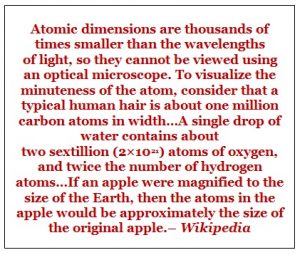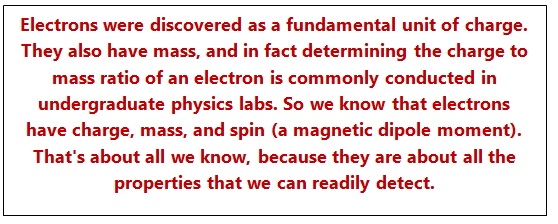The Ghostly Atom
Stagnation in scientific development is not the share of physics alone. Take any field: cosmology, biology, psychology; and even philosophy and theology. Everywhere you miss new ideas, new concepts or fresh thoughts. Rather, now it is stirring of the old pudding everywhere, writes SYED IQBAL ZAHEER.
It was some five hundred years before Christ that a few Greek thinkers conjectured that matter is made of particles, and that all things appear to be made of the same particle: wood, rocks, water, vapors – and all. They were all made up of the same fundamental particle. This particle was named atom. It was too tiny and was indivisible. (‘Atom’ meant ‘uncuttable.’) . If things looked different, smelt different, felt different (hot or cold), and tasted different, it was because they were assembled together differently. Otherwise, they were made of the same atoms.
Only in modern times it has been discovered that there are (half a dozen) types of atoms: stable, radioactive, etc., – although all the types are same in their structure. Thus, every solid, liquid, and gas is composed of atoms. Therefore, atom became the subject of study and research.
It was soon discovered that, even if indivisible, an atom appeared to be composed of other elements. It was realized that every atom consisted of one or more other materials which were chemically bound to it. It was conjectured that the atom was spherical, and a lump of newly discovered elements called electrons, surrounded it. It stuck to it by electromagnetic force. It was in 1913 or so that it was discovered that an atom had a nucleus of a solid material at the center with one or more electrons orbiting it. It was originally thought that the electrons were point-like particles that circled the nucleus at high speed. The picture was similar to the structure of our planetary system where the Sun occupies the central position orbited by its planets: Mars, Earth, Saturn, etc.
 An atom is of size 100 picometer where one picometer is one trillionth of a meter, i.e. (1/1000000000000. That is,1×10 -12 meter). A pin-head can comfortably accommodate millions of atoms.
An atom is of size 100 picometer where one picometer is one trillionth of a meter, i.e. (1/1000000000000. That is,1×10 -12 meter). A pin-head can comfortably accommodate millions of atoms.
The dense central part, the nucleus, has been penetrated. It is found to be composed of particles called protons and neutrons. It can be one proton and one neutron per atom, or, several protons and equal number of neutrons, and equal number of electrons orbiting the nucleus. Hydrogen has one electron orbiting the nucleus which has one proton. Oxygen atoms have 8 electrons orbiting the nucleus of 8 protons. Copper has 29 protons and 29 electrons.
The proton has two parts, 1) Quarks (two ‘up’ quarks, and one ‘down’ quark) … and (2) the Gluons. The Quarks are 3 in number, and it is the Gluons which are responsible for keeping the Quarks together within each atom.
The atom is mostly empty. More than 94% of its mass is in the nucleus. And the nucleus is so tiny that one could say it does not exist. The electrons are like a cloud. The atom is more an image than a physical unit. Says a scientific article: “Particles are not dots in space, but are more like ‘dancing points of energy.’” In the light of latest findings the planetary model in which an electron orbited the nucleus as a particle, had to be abandoned.
But, the invisibility is simply not because it is so tiny, but because of its shadowy existence at the atomic level. That is because, it is there now, and not there now. It has a dual quality of being. It behaves like a particle as well as like a wave.
And atoms join with each other – to produce molecules (any ordinary matter: an iron piece, brick, wood etc.). In all cases it is electrons of an atom joining with electrons of another atom. In other words, it is electrons alone of an atom, that join electrons of another atom and never the nucleuses.
This electron to electron joining is called covalent binding. And covalent bonding does not necessarily require that the two atoms be of the same element. They can be of different elements too. E.g. one atom of oxygen and2 atoms of hydrogen, successfully join together to become a molecule of water. But the nucleuses remain apart, even if water molecules are heated or cooled.
 At this point we might say, ‘Stop. Enough is enough.’ This one-page covers hundreds of pages of description of an atom. Atom appears to be too vast a subject.
At this point we might say, ‘Stop. Enough is enough.’ This one-page covers hundreds of pages of description of an atom. Atom appears to be too vast a subject.
Yet, despite such large material, produced by hundreds of scientist, (of whom more than 200 won Nobel Prizes in Physics) all over the globe, working over more than a century, we are left with dozens of unanswered questions to this day: “What is dark matter? Why is a neutron heavier than protons by just one per cent? Where did all the antimatter go?” etc.
The research goes on. But since last quarter of a century, the yield is discouraging. Science seems to be stagnating. The search for the ‘final truth’ is evading. The scientists do not know what to make of their discoveries. For instance:
Experiments show that an atom seems to be in two places at the same time. When two  particles are ‘quantum-entangled’ and each is placed in different locations, in an experiment 21 km apart, then, amazingly, each seems to know what is happening to the other. (Each location requires billions of dollars to build with machineries and equipment).
particles are ‘quantum-entangled’ and each is placed in different locations, in an experiment 21 km apart, then, amazingly, each seems to know what is happening to the other. (Each location requires billions of dollars to build with machineries and equipment).
For example, if the polarization of one of the entangled atom is changed from positive to negative, the other entangled atom in the other location unconnected to the first location, changes its polarization from negative to positive instantly, without delay of a microsecond. The information between the two particles appears to travel from one to the other location, at speed faster than that of light: 300,000 km a second. This contradicts the Theory of Relativity. But this theory is firmly established. It has been tested by the best of minds over a century and has stood all tests to emerge as true in flying colors. Quantum theories are, on the other hand, demonstrable in any lab. But the quantum theory and relativity cannot co-exist in a single theory. They contradict each other.
But the stagnation in scientific development is not the share of physics alone. Take any field: cosmology, biology, psychology … and even philosophy and theology. Everywhere you miss new ideas, new concepts or fresh thoughts. Rather, now it is stirring of the old pudding everywhere.
We might, at this juncture, remind ourselves of a statement in Allah’s Book: “They will not comprehend aught of His knowledge, save such as He wills.” (2: 255)

